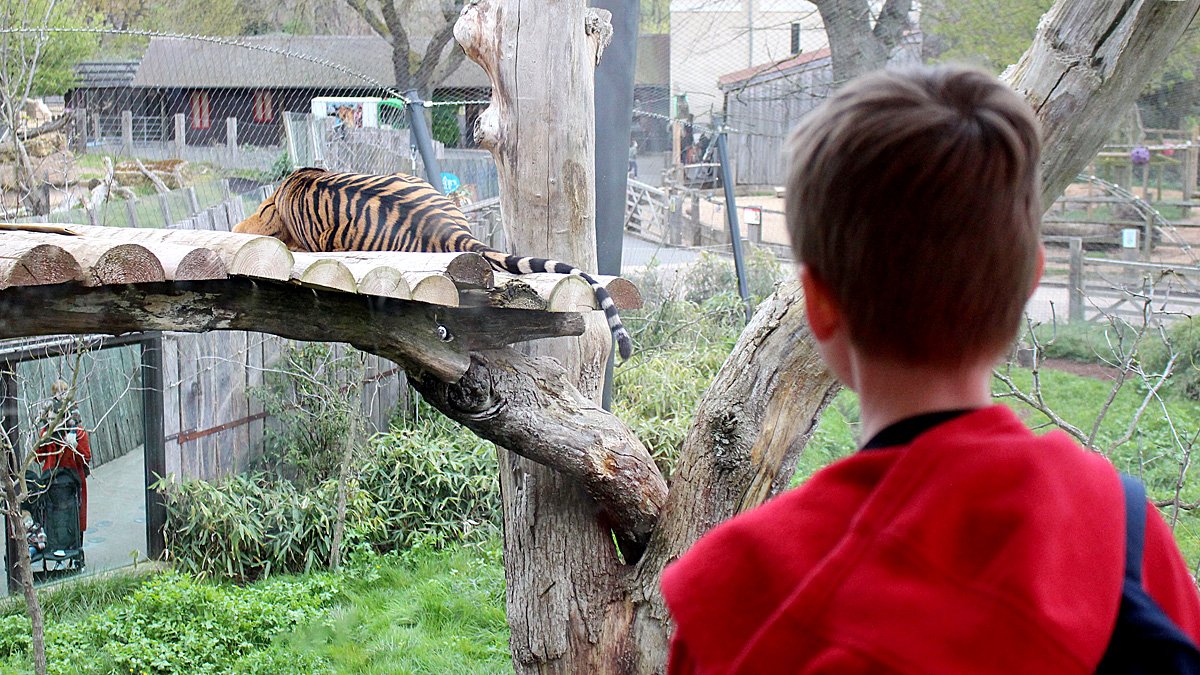
Last week, London Zoo invited us along to spend the day. We had a great time exploring the various animal enclosures, watching a feeding at the penguin beach, and finding the spot where Harry Potter let loose a boa constrictor! London Zoo is run by conservation charity ZSL (the Zoological Society of London) who also runs Whipsnade Zoo in Bedfordshire.
Getting to London Zoo
London Zoo is located in Regent’s Park, right in the middle of central London. We traveled in from our station at King’s Cross by the underground and walked from Camden Town which took around fifteen minutes but would have taken even less if the signage was more clearly marked. On the way, we spotted ample parking for those wanting to drive.
On arrival, there were plenty of staff members milling around the entrance helping to direct people to the correct line they needed, and we were soon inside, map in hand.

Conservation at London Zoo
One of the things I was most interested in when visiting London Zoo was how the zoo contributes to conservation, rather than just being an opportunity to gawp at wild animals in cages as zoos frequently used to be. Conservation is clearly paramount as the zoo is run by ZSL, an “international conservation charity working to create a world where wildlife thrives”.
Every animal enclosure has a sign which tells you about the animal you’re visiting. These signs not only tell you about the animal itself, but they also explain its diet, natural habitat, and conservation status – ranging from “least concern” to “extinct in the wild”. During our visit, we spotted numerous different species that were listed as “endangered” or “critically endangered”. The signs also explained the story behind the animal’s conservation status. In the case of the endangered okapi, the sign explained that human conflict was behind its status, due to armed groups hunting them for meat while logging and mining in the forests where they live. These signs helped us to understand more about the animals we were seeing, and my son used them to complete work toward his Animal Carer badge for Cub Scouts while we were there.
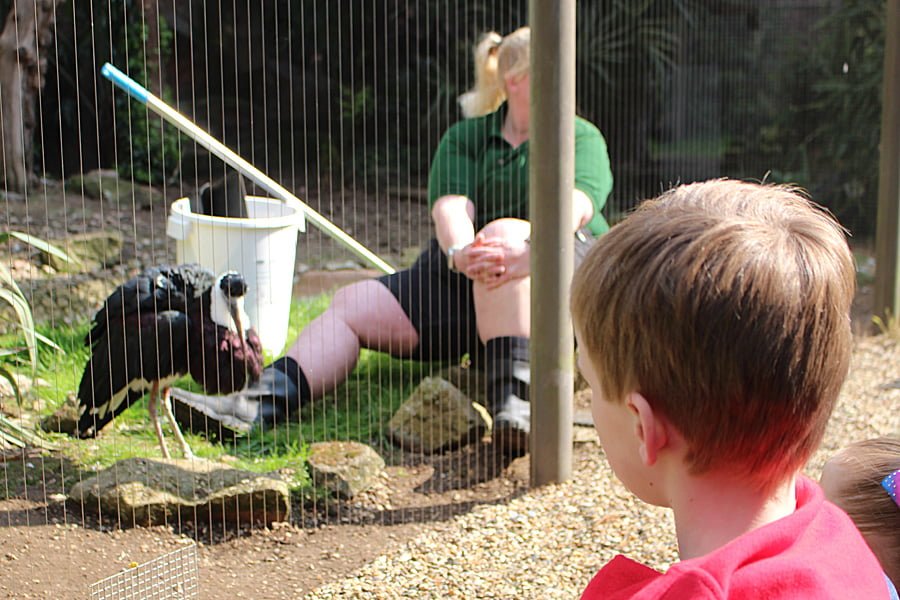
During our time at London Zoo, all the animals seemed happy and healthy and although some of the older enclosures did feel a little small, efforts are clearly underway to improve the entire place piece by piece. I didn’t spot any animals displaying any worrying behavior such as pacing up and down, instead, they all seemed very relaxed and happy. Signs were also displayed around animals who might give the public cause for concern. A temporary sign up near a rather scruffy-looking camel informed us not to worry about him, he is merely in the process of shedding his winter coat at this time of year and therefore not looking at his best.
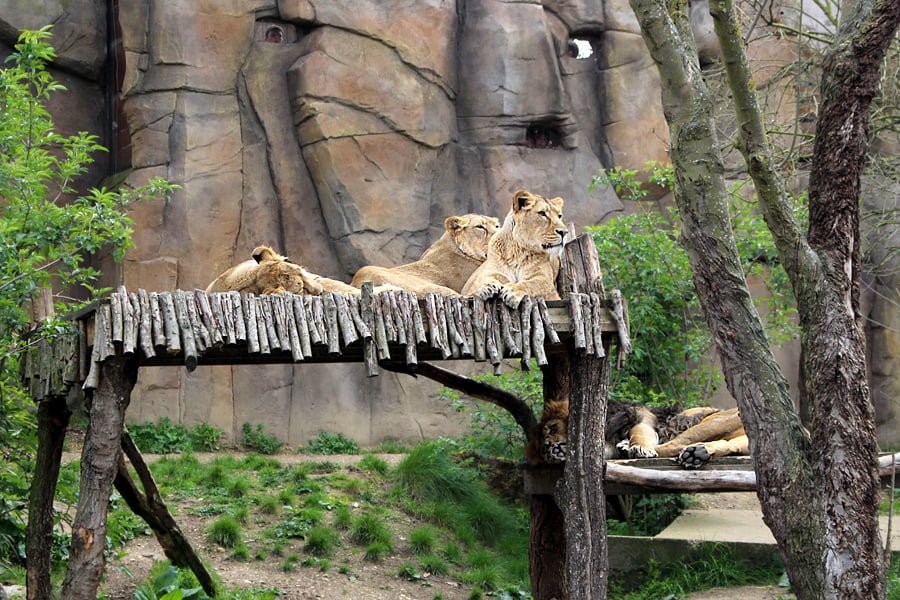
Land of the Lions
Land of the Lions is one of the newest areas at London Zoo and you can really tell. This large section ended up being my favorite part of the zoo. The entire area is stunningly themed, easily rivaling Disney’s Animal Kingdom in terms of attention to detail. Near the entrance are several small food stands set up to look like an Asian street, here you can pick up hot or cold food to eat in the courtyard before you set off on your trail through a recreation of Gir National Park. There’s even a recreation of an abandoned railway station to look around.
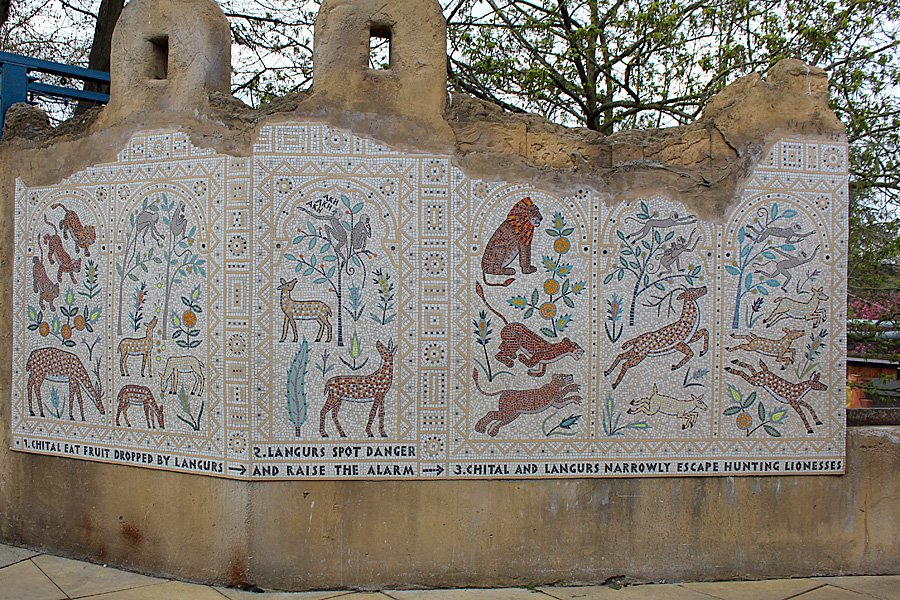
There are three different trails you can walk on in Land of the Lions with different amounts of steps included in each. We picked the central, pink path which took us up through the langur temple which was filled with beautiful murals, traditional Asian style paintings, and even a shrine to the Hindu goddess Durga. Here we could spot the langur monkeys sitting around on the temple roof around us before we proceeded deeper into the park to see the lions themselves. There are multiple spots to see the lions from different angles and they were chilling out on top of a viewing platform during our visit. The enclosure is designed to give you a clear view without lots of fencing while keeping the lions at a safe distance and giving them plenty of space to explore when they’re not sleeping in the sun like the big cats they are.
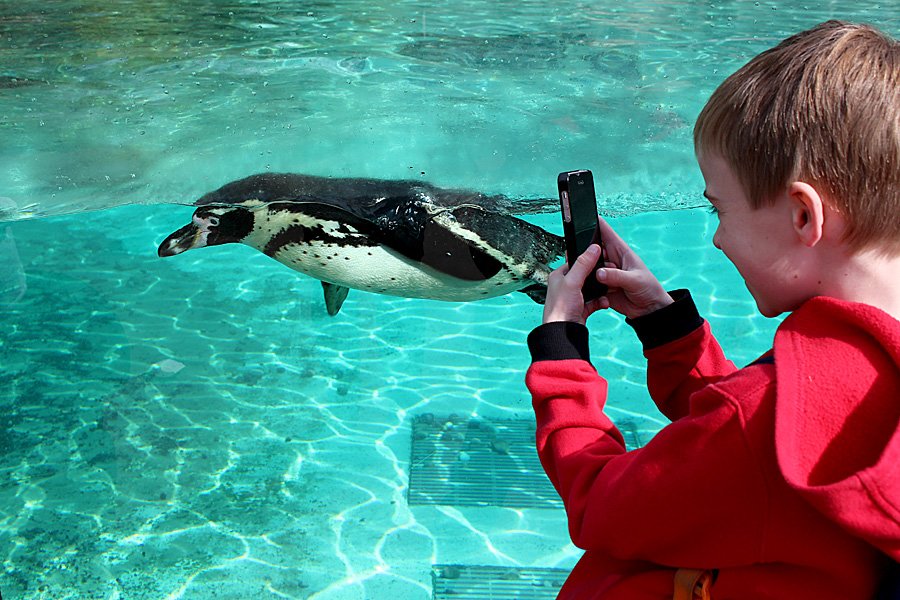
Penguin Beach
My son’s favorite part of the park was Penguin Beach, a recreation of a South American coastal landscape which is home to a large colony of Humboldt penguins. There are many viewing areas around the beach which allow you to see both above and below the water. My son loved looking around below the water level where he could get really close to the penguins as they swam past, often rubbing themselves along the glass as they went.
We visited this area of the park several times throughout the day, including during Penguin Beach Live! This short talk happens multiple times a day while the penguins are being fed and it attracted a large crowd but the design of the area meant we were easily able to walk up and get a good view. The keeper who ran the show told us all about different penguin species including their various diets and habitats across the southern hemisphere. I was also amused to spot a number of wild herons who had clearly learned the zoo’s feeding schedule and who showed up to steal some fish!

B.U.G.S.
My son was nervous about entering the B.U.G.S. building (whose name stands for Biodiversity Underpinning Global Survival) as he is afraid of spiders, however, after poking our heads inside, we discovered that the spiders are kept in a separate and clearly marked area which can be easily avoided entirely so he was willing to come inside. We ended up spending a very long time inside B.U.G.S. and finding this one of the most interesting parts of the park.
The building is mostly home to invertebrates. We were amazed at the leaf cutter ants who roam happily along exposed ropes from tank to tank, as well as some enormous stick insects and a literal swarm of locusts. Other interesting tanks contained cockroaches, various forms of beetles, and a honey bee colony designed using glass to allow you to see inside. One section was undergoing refurbishment so next time we visit, there will be even more to see here. All of the tanks were themed appropriately to the habitat of the animals inside, including one for a species of North American cockroach that looked like a kitchen and had the bugs feasting on Cheerios.

There were also various interactive elements in the building including a group of mirrors that mimics an insect’s eye and a microscope that allowed you to see some microscopic life up close. My son was especially fascinated by the microscope and we spent a good few minutes working our way through the various slides and viewing them on the big screen attached to it.
Before we left, I briefly stepped into the spider area to have a look in some of the tanks. However, I wasn’t quite up to walking through In With the Spiders – the UK’s first ever walk-through spider exhibit. This exhibit allows you to walk through a room full of spiders with no barriers between you and them. The spider area is used for the zoo’s Friendly Spider Programme which uses CBT and hypnotherapy to help arachnophobes cure their fears in one afternoon.
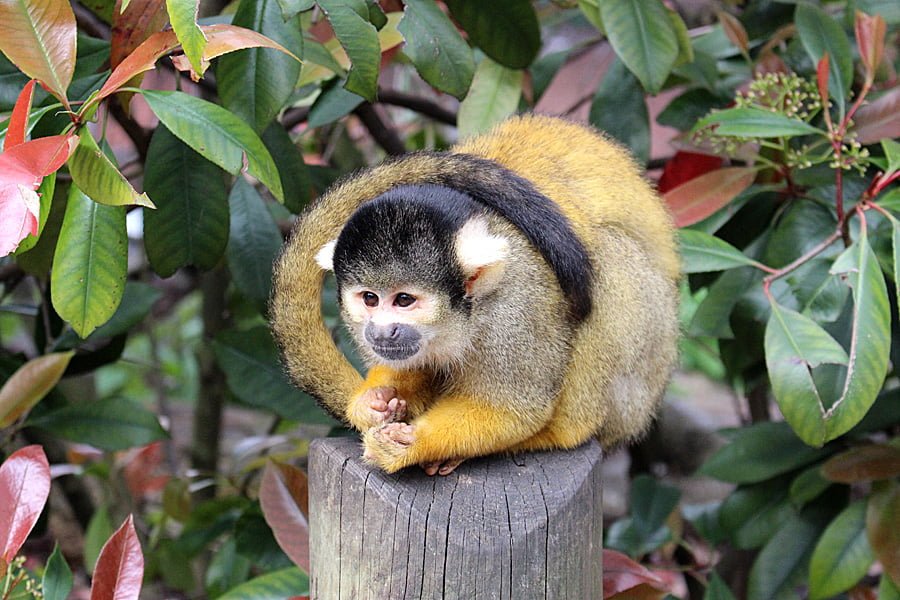
Interactive Areas
There are multiple interactive areas scattered throughout the zoo where you can get up close with the animals without netting or glass between you. The “In With the…” sections allow you to walk through areas of the zoo where animals roam around with you; currently, these include lemurs, monkeys, and spiders. There is also the Butterfly Paradise where you can walk through a swelteringly hot greenhouse filled with hundreds of colorful butterflies from around the world. There was a mirror positioned by the exit of this exhibit so you could check your clothes for hitchhikers before leaving!
The only area where you are invited to freely touch the animals is The Farmyard where kids and adults can stroke a variety of small farmyard animals including a number of goats who my son immediately fell in love with. Handwashing facilities are provided at the exit of this section.
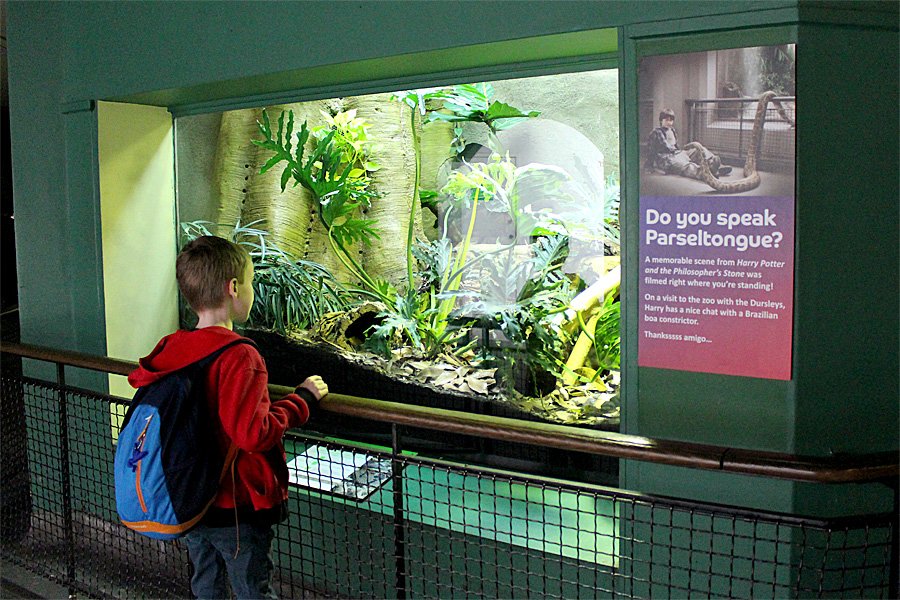
Reptile House and Aquarium
The Reptile House is one of the most famous parts of London Zoo thanks to its appearance in Harry Potter and the Philosopher’s Stone in the scene where Harry and the Dursleys visit the zoo and Harry accidentally releases a boa constrictor from its tank. This spot is marked by a sign on the wall to help you easily identify it although the tank doesn’t currently contain that type of snake which is a shame. The Reptile House is huge with many species of snakes, lizards, and amphibians inside. We had fun trying to spot them all, some of which were nearly impossible to find. One notable tank contained a reptile skin handbag in a powerful message about how animals will disappear if we continue to kill them for our own purposes.
Just across from the Reptile House is the Aquarium which is currently undergoing a major refit. Although not the most impressive aquarium I have visited, there are still a good number of beautiful displays in here and I was pleased to spot a tank given over to visualizing the dangers of single-use plastics on the oceans.
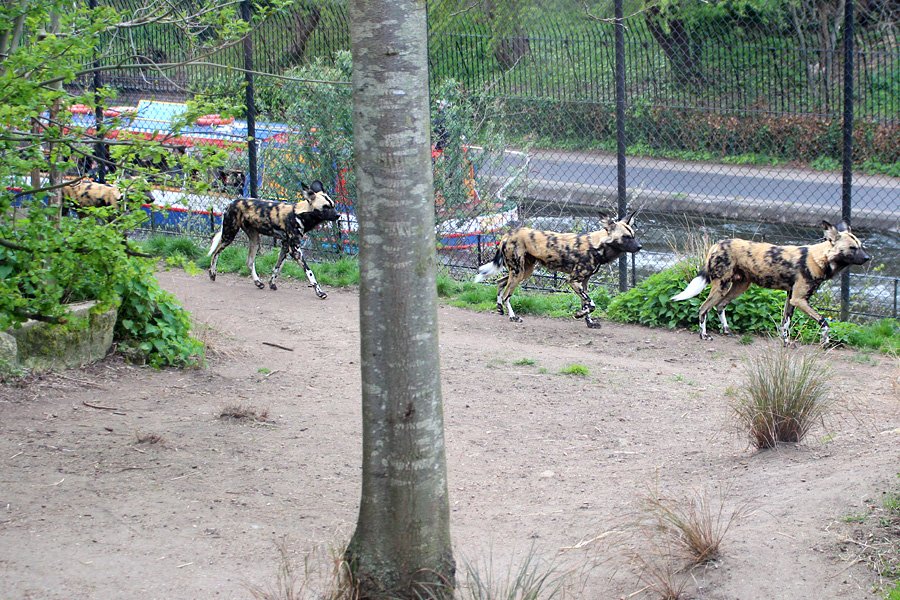
Into Africa
London Zoo actually spans both sides of a road, so there are two tunnels that lead under it to take you across to the section on the far side. Both of the tunnels are filled with interesting murals and timelines than brighten up the walk over. The area on the far side of the road houses the Into Africa area along with In With the Lemurs, Meerkats & Otters, and the Rainforest Life and Nightlife building.
The Into Africa area hosts giraffes, zebras, hunting dogs, and other creatures you probably think of when envisioning the savannah. It wasn’t very well themed compared to some other areas and some of the buildings here date back a long way to the zoo’s early days. We arrived in the giraffe house just as a group was there to feed them and the giraffes seemed pleased by all the attention. According to the map, this area is due for a “major new development” next year and I’m curious to see what that ends up being. I hope that the Africa area gets a much-needed spruce up at the same time.

Rainforest Life and Nightlife
Further down from Into Africa is the Rainforest Life and Nightlife building which is split into the two areas down the middle. The Rainforest Life side of the building lets you walk around the upper level of the building, looking down into an open rainforest environment where multiple species including monkeys, tortoises, and bats interacted freely. On this level, which was beautifully themed, we got to get up close with a pair of sloths and there were several other smaller enclosures containing animals like mongooses and piranhas. My son was amazed by a giant infographic banner that discussed the medicinal value of the rainforest and how little of the plant life that grows there we have even tested for its medical benefits.
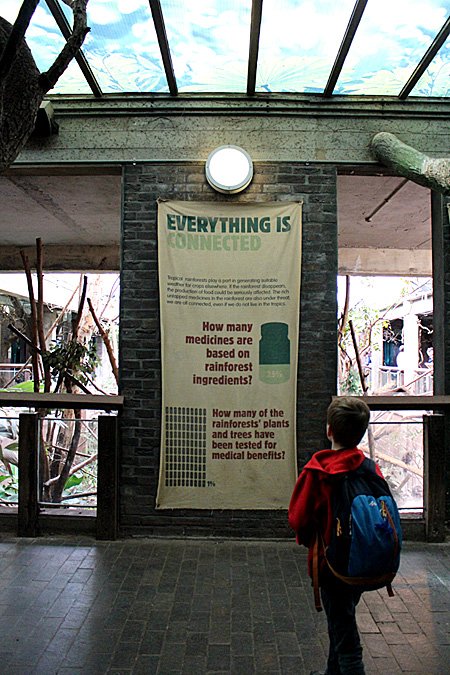
The Nightlife section of the building is home to many nocturnal creatures and so the lights are very low with minimal red tinged lights so you can see. Here you can see bats, bush babies, and an amazing aye-aye as well as something called an Australian giant jumping rat that is much cuter than its name suggests. This area of the building was fascinating as it contained animals you rarely see in other zoos and wildlife parks, but the smell was overpowering and it took our eyes a while to readjust to the bright sunshine when we came back outside!

Food, Drink, and Shopping at London Zoo
Naturally, there are several commercial establishments inside London Zoo, although not as many as I was expecting. While there are a few small food carts and stands around the place, most of the food is served in The Terrace. This building is open all day for drinks and pastries, but the restaurant area itself has limited hours just over lunchtime.
We found The Terrace restaurant to be something of a letdown. The queuing system was badly organized and forced you to queue multiple times to get different kinds of food. We collected my son’s fish fingers and fries first but this meant that the queue for pizzas had grown by the time we joined it. We ended up waiting so long that by the time we had queued a third time to pay, my son’s food had almost gone cold. The range of foods on offer was excellent (you can see a menu on the London Zoo website), the prices reasonable for a central London tourist attraction, and the baked goods were delicious- but the organization seriously let it down. It’s also worth mentioning that all the food served at The Terrace comes from ethical sources including sustainable fish stocks, welfare-conscious farms, and fruit and vegetables sourced as locally as possible.

In terms of shopping, I was pleasantly surprised by how little the zoo took the opportunity to sell me and my son things. There are a handful of small kiosks dotted around but these are few and far between. The one concession the zoo makes to retail therapy is by making you leave through a large gift shop, however, I found many of the items on sale here to be very reasonably priced compared with other tourist attractions I have visited recently. We were able to buy three stuffed animals, two iron-on patches, and two magnets for the cost of a single picture frame at a theme park we visited last year. Items bought in the shop help fund the conservation arm of the zoo’s work too, which helped me feel a bit better about giving in to the purchase of extra items.
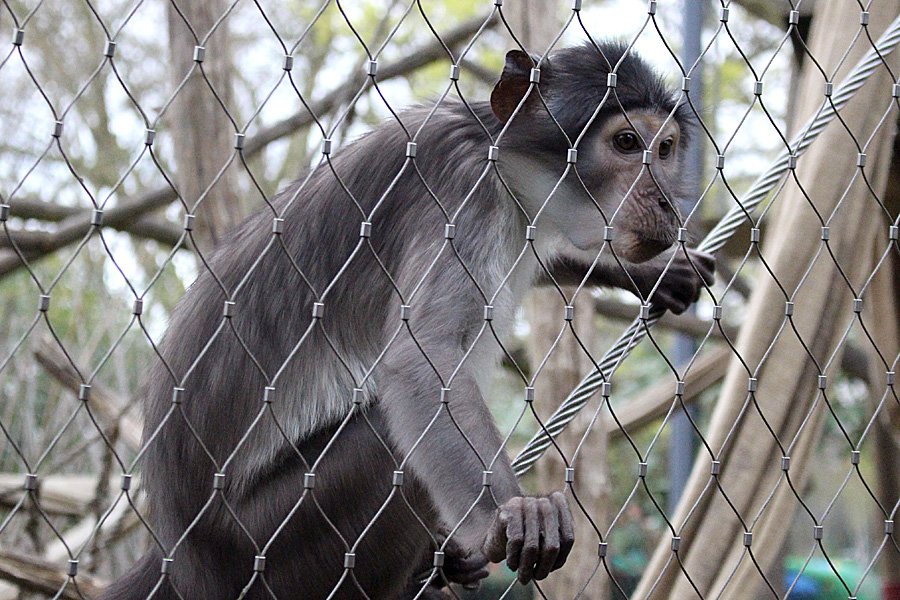
Is London Zoo Worth a Visit?
In a word: absolutely. I was really impressed by how much is packed into London Zoo considering its Central London location. The zoo looks quite small on the map but we found there was more than enough to do to occupy an entire day and that was without doing any of the special encounters, or watching any of the shows beyond the penguin feeding. We were there from around 10:30am to 6:00pm and could easily have filled a second day at the zoo by attending some of these events and simply spending longer with some of our favorite animals. For those wanting to do a full tour of Harry Potter’s London, this is a must visit too and its location close to King’s Cross makes the two places easy to cover in a single day.
The zoo’s focus on conservation will ease the minds of those worried about visiting a zoo. All the animals looked well cared for and the staff members were incredibly knowledgable and happy to talk about the animals at great length, both to curious kids and equally curious adults. There are always lots of staff members around at every exhibit, keeping a close watch to make sure visitors don’t put themselves or the animals at risk. One staff member in the Rainforest Life building spent a good ten minutes talking to us about the building and its animals.
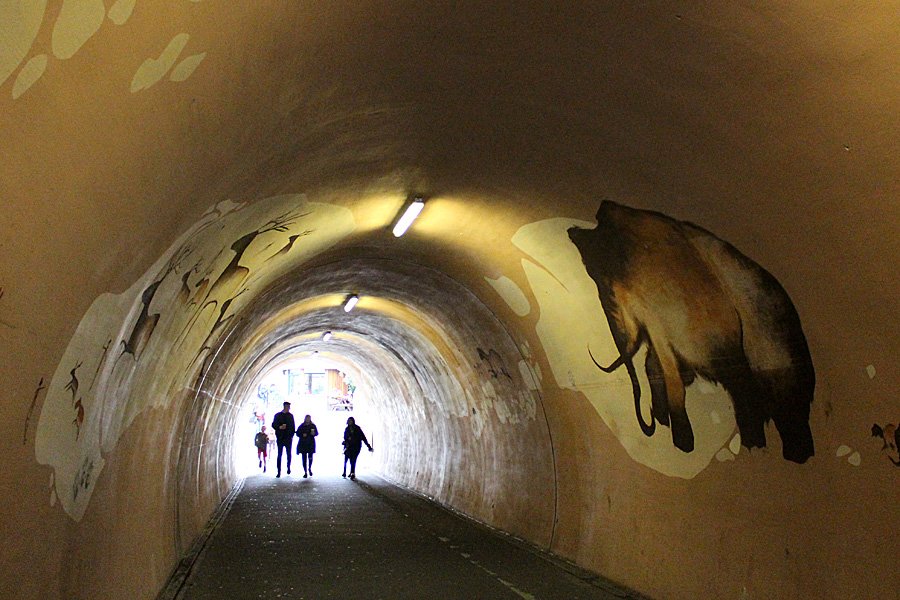
My son has already asked to go back to London Zoo and there is more than enough left to do there to warrant us taking a second trip at some point soon. He is hoping to attend one of the Mini Keepers sessions running during school holidays this year where kids get to help out looking after animals including squirrel monkeys and meerkats. I’m sure we will be back at London Zoo soon and can highly recommend this as a great family day out for all animal lovers and budding conservationists.
GeekMom received complementary tickets to London Zoo for review purposes.


